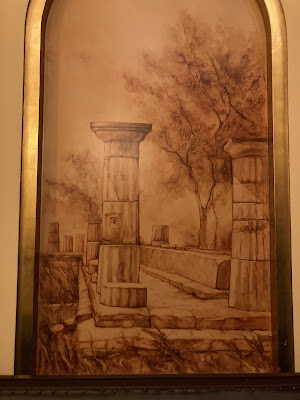 |
| ‘Brethren, be clothed.’ |
Before the meeting last Saturday of Quinta Essentia Lodge 500 recedes into foggy forgetfulness, let me share a few details of a fantastic evening in New Haven.
 |
| No nightmares in The Elm City Club on Elm Street. |
I have wanted to get up there for a visit for a number of years. I met Bro. Jay at his home in the northeast corner of New Jersey and he did the driving—kind of a haul, actually—into Connecticut. The lodge meets inside The Elm City Club, a private, members-only establishment that originated, if I understand correctly, as the Graduates Club, a social space for Yale University people. Located on Elm Street, it is situated in the center of the campus area. Elm City is New Haven’s nickname.
The plan was for the lodge to meet, close, and then have dinner in the same room, but signals got crossed and we dined in a larger space that surely was the more comfortable option—although it was weird having the wait staff circulating about while our speaker was presenting. The lodge meeting was brief. Quinta Essentia gained one more brother, as Bro. Rodney, Master of Shakespeare Lodge 750 here in Manhattan, was elected to membership. Huzzah! (They employ a unique method of balloting, involving two ballot boxes, that I’ve never seen before.)
 |
| Worshipful Master Jonathan Glassman’s commemorative coin is a hefty two inches in diameter and about a pound and a half in weight. |
Our keynote speaker was Chris Murphy of Vermont, who presented “The Traditional History: Freemasonry’s Foundational Mythos.” I envy gifted speakers, and Bro. Chris has the talent that eludes me. I didn’t take notes, but this was an explanation of how and why the Masonic Solomon’s Temple is not the same story as that found in the Bible. Our story differs and has many details, as you know, that are not Scriptural. I wouldn’t want to divulge too much here, but my take in one sentence: While we today do not accept the histories rendered in the Old Charges and by Anderson as accurate records, we should appreciate speculatively about how a Masonic DNA, divinely placed, nevertheless connects Adam to us. Just terrific!
 |
| History in a tobacconist. 268 College Street. |
Before arriving at The Elm City Club, Jay and I visited The Owl Shop, the storied tobacconist and bar on College Street that also has been on my list of places to be. I’ve seen Life magazine photos on the web of Yale men at their pipe club and of tobacco tins displaying the Yale “Y,” and this establishment, which opened in 1934, is connected to those. They sell cigars, naturally, and the air inside was thick with smoking aroma. But it wasn’t hazy and oppressing. Two days earlier, I caught the new Linklatter film. In it, the lyricist Lorenz Hart (Ethan Hawke) exclaims he loves the smell of cigar stores, and the environment of The Owl Shop undoubtedly is the kind of thing he’s talking about.
 |
| Whatever air cleaner they use is inconspicuous. Only the ceiling fans are obvious. Great place to relax, smoke, and drink. |
We sat down, had a round of drinks (I enjoyed a Warsteiner Dunkel while Bro. Jay was fortified by a reddish tea), and shared a cheese board. No smoking, as time didn’t permit it, but I purchased an ounce of Harkness Tower, their Balkan house blend, to bring home. I’m going to try some tomorrow.
 |
| An ounce of Harkness Tower to go. |
 |
| During the holidays, I’m going to try this rye. 100 proof! Zoinks! |
A great way to spend a Saturday! Unfortunately, New Haven really is just far enough away to not be a place to frequent, but, edified by this experience, I don’t know why I wouldn’t visit the lodge and smoke shop at least once a year.

























































































